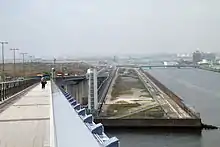Central Breakwater
The Central Breakwater (中央防波堤, Chūō bōhatei) is a breakwater and artificial island located in Tokyo Bay, adjacent to the Tokyo Gate Bridge.
History

The Central Breakwater was first constructed in 1973 and has been used as a site for waste disposal from Tokyo since then, forming two artificial islands in Tokyo Bay known as the Inner Landfill (内側埋立地) and the Outer Landfill (外側埋立地). The islands had a combined area of 377 hectares in 2011 and are expected to ultimately reach an area of 989 hectares.[1]
Jurisdiction dispute
Jurisdiction over the Central Breakwater islands was disputed between the special wards of Koto and Ota for 4 decades. Under Japanese law, any boundary dispute may be submitted to the prefectural government (in this case, the Tokyo metropolitan government) for resolution; a similar dispute with regard to the nearby Odaiba and Ariake area was resolved in 1982 by splitting the area between the three special wards that claimed it.[1] Koto has argued that the garbage used to create the landfill was hauled through Koto and that making the island part of the special ward would repay residents for their trouble, while Ota has argued that the site of the breakwater was historically used by Ota-based nori cultivators, and that the island should be managed in coordination with nearby Haneda Airport (which is part of Ota). The dispute is mainly considered an issue of brand image; jurisdiction over the island offers little practical benefit to the special wards, as fixed asset taxes on real estate are collected by the metropolitan government.[2]
On October 3, 2019 Tokyo District Court ruled 79.3% of the Central Breakwater landfills to Kōtō Ward and 20.7% to Ōta Ward for multiple decades. Ota Ward stated that it won't appeal the ruling. Thus the 40 year dispute was closed.[3]
From December 17 to January 31, 2020 the public made 532 proposals for the town name of the west side to be incorporated in Ota Ward. On 1 June 2020, Reiwajima (令和島) became the official name.[4] The east side of Koto Ward uses the name Sea Forest (海の森) which they were accustomed to.[5]
2020 Summer Olympics
The Central Breakwater is one of the planned venues for the 2020 Summer Olympics. The Inner Landfill will host the Sea Forest Cross-Country Course for equestrian events, while the Outer Landfill would have hosted the Sea Forest Mountain Bike Course but was eventually moved to Izu, Shizuoka. The waterway between the two islands, named Sea Forest Waterway, will be used for rowing and kayaking events. The venues will be maintained as recreational areas after the Games.[6]
References
- "東京湾埋め立て地めぐり 江東区と大田区が「領土争い」". J-CASTニュース. January 15, 2011.
- "Article". www.nikkei.com. Retrieved 2020-02-06.
- "Tokyo Bay reclaimed land ownership dispute Ota Ward decided without appeal". Teller Report (from NHK News). Archived from the original on 2019-10-07. Retrieved 2019-10-07.
- 【プレスリリース】大田区に新しい住所「令和島」が誕生します - 大田区役所公式サイト (2020年5月28日)
- 大田区vs江東区の「領土争い」決着から9か月 両区が付けた新たな町名を知っていますか?ト (2020年6月10日)
- "Archived copy". Archived from the original on 2013-07-27. Retrieved 2013-07-08.CS1 maint: archived copy as title (link)